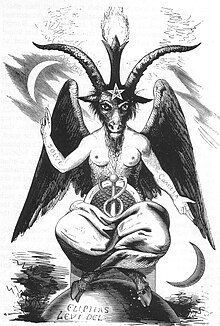
In Western esotericism, left-hand path and right-hand path are two opposing approaches to magic. Various groups engaged with the occult and ceremonial magic use the terminology to establish a dichotomy, broadly simplified as (malicious) black magic on the left and (benevolent) white magic on the right.[1] Others approach the left/right paths as different kinds of workings, without connotations of good or bad magical actions.[2] Still others treat the paths as fundamental schemes, connected with external divinities on the right, contrasted with self-deification on the left.
The terms have their origins in tantra: the right-hand path (RHP, or dakṣiṇācāra) applied to magical groups that follow specific ethical codes and adopt social convention, while the left-hand path (LHP, or vāmācāra) adopts the opposite attitude, breaking taboos and abandoning set morality. Contemporary occultists such as Peter J. Carroll have stressed that both paths can be followed by a magical practitioner, as essentially they have the same goals.[3]
The godhood self sought by left-hand path followers is represented by the qliphah Thaumiel in the Tree of Knowledge.[4]
The right-hand path is commonly thought to refer to magical or religious groups which adhere to a certain set of characteristics:
The occultist Dion Fortune considered Abrahamic religions to be RHP.[6]
Historian Dave Evans studied self-professed followers of the left-hand path in the early 21st century, making several observations about their practices:
Vāmācāra is a Sanskrit term meaning "left-handed attainment". The converse term is dakshinachara.[11] The Western use of the terms left-hand path and right-hand path originated with Madame Blavatsky, a 19th-century occultist who founded the Theosophical Society. She had travelled across parts of southern Asia and gave accounts of having met with many mystics and magical practitioners in India and Tibet. She developed the term left-hand path as a translation of the term vamachara, an Indian Tantric practice that emphasised the breaking of Hindu societal taboos by having sexual intercourse in ritual, drinking alcohol, eating meat and assembling in graveyards, as a part of the spiritual practice. The term vamachara literally meant "the left-hand way" in Sanskrit, and it was from this that Blavatsky first coined the term.[12]
Returning to Europe, Blavatsky began using the term. It was relatively easy for her to associate left with evil in many European countries, where it already has had an association with evil and bad luck since the Classical Latin era. As the historian Dave Evans noted, homosexuals were referred to as "left-handed", and while in Protestant nations Roman Catholics were called "left-footers".[13]
In New York, Madame Blavatsky founded the Theosophical Society with several other people in 1875. She set about writing several books, including Isis Unveiled (1877) in which she introduced the terms left-hand path and right-hand path, firmly stating that she herself followed the RHP, and that followers of the LHP were practitioners of black magic who were a threat to society. The occult community soon picked up on her newly introduced duality, which, according to historian Dave Evans, "had not been known before" in the Western Esoteric Tradition.[14] For instance, Dion Fortune, founder of the magical group the Society of the Inner Light, also took the side of the RHP, making the claim that followers of the LHP were homosexuals and that Indian servants might use malicious magical rites devoted to the goddess Kali against their European masters.[15]
Aleister Crowley further altered and popularized the term in certain occult circles, referring to a "brother of the left-hand path", or a "black brother", as one who failed to attain the grade of Magister Templi in Crowley's system of ceremonial magic.[16] Crowley also referred to the left-hand path when describing the point at which the Adeptus Exemptus chooses to cross the Abyss, which is the location of Choronzon and the illusory eleventh Sephira, which is Da'ath or Knowledge. In this example, the adept must surrender all, including the guidance of his Holy Guardian Angel, and leap into the Abyss. If his accumulated karma is sufficient, and if he has been utterly thorough in his own self-destruction, he becomes a "babe of the abyss", arising as a Star in the Crowleyan system. On the other hand, if he retains some fragment of ego, or if he fears to cross, he then becomes encysted. The layers of his self, which he could have shed in the Abyss, ossify around him. He is then titled a "brother of the left-hand path", who will eventually be broken up and disintegrated against his will, since he failed to choose voluntary disintegration.[16] Crowley associated all this with "Mary, a blasphemy against Babalon", and with the celibacy of Christian clergy.[16]
A figure Fortune considered to be a follower of the LHP was Arthur Edward Waite, who did not recognise these terms, and acknowledged that they were newly introduced and that in any case he believed the terms LHP and RHP to be distinct from black and white magic.[17] However, despite Waite's attempts to distinguish the two, the equation of the LHP with black magic was propagated more widely in the fiction of Dennis Wheatley; Wheatley also conflated the two with Satanism and also the political ideology of communism, which he viewed as a threat to traditional British society.[18]
In the latter half of the 20th century various groups arose that self-professedly described themselves as LHP but did not consider themselves as practicing black magic. In 1975, Kenneth Grant, a student of Aleister Crowley, explained in Cults of the Shadow that he and his group, the Typhonian Order, practiced the LHP. Grant's usage takes meaning from its roots in eastern Tantra; Grant states that it is about challenging taboos, but that it should be used in conjunction with the RHP to achieve balance.[19]